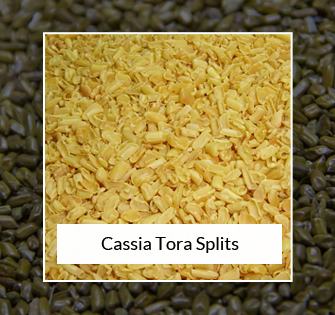About Cassia Tora Splits
Cassia tora splits is manufactured from the seeds of Senna obtusifolia or Cassia obtusifolia or Cassia Tora or Cassia Occidentalis.
Cassia grows mainly in subtropical regions and is grows mostly wild and occasionally cultivated. The name is derived from Latin words “obtus” meaning blunt and “folium” meaning leaf. This is annual plant that mainly grows after the Indian monsoon season. This plant bears pods of nearly 20cm which contain many cylindrical seeds. These are the cassia tora seeds that are usually broken into two halves and referred to as cassia splits.
These splits are usually called by different names like cassia tora gum splits, cassia gum splits, cassia splits, senna splits, cassia senna splits etc.
Specification of Cassia Senna Splits
| Odour | Typical |
|---|---|
| Moisture | 7% Max. |
| Ash % | 1% Max. |
| Protein | 7% Max. |
| Black & Red | 1% Max. |
| Dehusking | 93% |
Manufacturing Process Cassia Tora Splits
The seed consists of an outer husk, an endosperm (cassia tora split), and the ovary or germ. Only the endosperm or split, which contains mainly polysaccharides, is used for the production of cassia gum.
As one of the major cassia split manufacturers, before splitting, the seeds are passed through grading machines to differentiate them on the basis of their size. During this procedure, the underdeveloped seeds are removed and C.occidentalis seeds are reduced to no more than 0.05%.
Both husk and germ are removed in the de-husking and splitting process. The impact of the splitting procedure is that both husk and germ are loosened from the endosperm and made brittle by heating and can be removed in the subsequent purification procedure after pulverization. The split (endosperm), however, remains intact at these temperatures. Due to its much greater particle size, the split can be separated from husk and germ particles through a couple of physical cleaning steps.
The splitting procedure starts with the roasting of the seeds. All seeds are heated for several minutes. During the roasting process the endosperm (split) remains intact and flexible, while husk and germ, which are more sensitive to heat, become brittle. Mechanical stress pulverizes husk and germ and the powder is separated from the intact split by sieving. The remaining traces of husk and germ on the split cassia particles are finally removed through a series of physical cleaning steps.
Cassia splits mainly consist of mannose and galactose units. These are pale yellow splits that are normally soluble in hot water. They act as thickening agents and form gels with carrageenan and xanthan. These Cassia Tora splits are often used as food additives. They are used in cattle feed products like dog foods, cat foods, and cow foods.
Cassia Tora Splits Packaging
- 50 kg net strong HDPE bags with inside liner
- 800 kg to 1000 kg jumbo bags or big bags
Application of Cassia Splits
- Making cassia gum powder.
- Making Textile-grade cassia gum powder
- Making different cassia derivatives.








